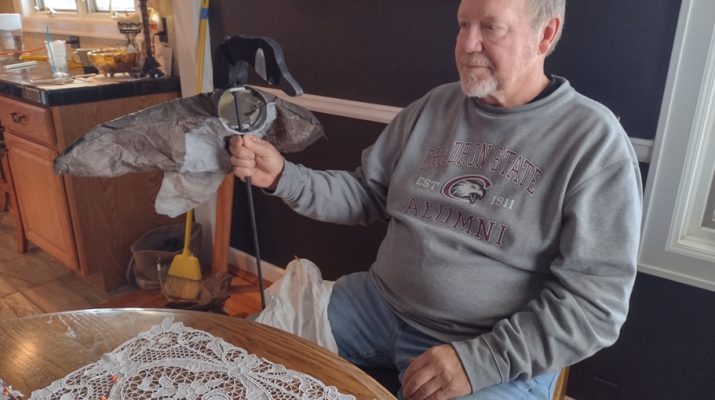Only blocks from where streets end and fields begin, our house is below commuting Canada geese. The V-shaped flocks fly between nesting and feeding grounds near Alliance for weeks. I think the long-necked birds had left for the season when we began collecting peanut butter jars for goose decoys at the recycling center earlier this year.
Meticulously cleaned or still holding enough chunky style for another sandwich, it didn’t matter. The jars, requested by local hunter Dana Bentley, soon filled several bags. A few weeks into goose season, I had an opportunity to visit with him about how Peter Pan or Jiff, perhaps, figured into creating new decoys.
Meeting Dana, I initially pictured the No. 1 plastic containers serving as a source of buoyancy for floating decoys. He quickly dispelled that notion, explaining close to four dozen jars were among materials recycled to make wind sock-style decoys. Instead of the whole thing, Dana repurposed the lids for snow geese and cut the mouths off the top for Canada geese.
First, Dana found 4-foot Canada goose decoys on a website based in Minnesota. Then, he cut them down to actual size and touched up and painted the material with an airbrush. Used styrofoam became the heads. Broken posts from electric fences served as stakes. And the jar mouths? These pieces were just the right size and rigid enough for the opening that allows wind to inflate and move the faux goose. He also incorporated used plastic from beet trucks to give body to some of the decoys when there is no wind. For the snow geese, Dana took legs off plastic white overalls collected over years working on the railroad. Then he sews the material and lids into one piece – this style works without heads. “Cost some sewing and black paint,” Dana said. “(The decoys) will last about 15 years.
“I didn’t start it to be a recycler, but we’re using a bunch of stuff that would have been in the landfill.”
Buying, crafting and deploying just the right decoys is always a work in progress even after decades returning to the blind. Dana talked about how goose hunters are a “breed unto themselves” especially the habit of keeping detailed logs every season. “Six years old in ‘59, I shot my first goose,” he said. Though Dana has tried numerous locations and habitats, he often hunts on land on the river by Melbeta. “Last year was horrible because it stayed nice ‘till the last week of goose hunting.”
In addition to recycling items to attract geese, Dana used scrapwood purchased from the railroad before he retired to build all his blinds. Old crates enjoy a new life, now topped with new long grass cut from local landscaping.New “peanut butter geese” are only part of the flock. There are also full bodies and shells (half decoys) as well as ones that imitate specific behaviors: sleepers, feeders, sentries and floaters – mostly for creeks. Dana said, “Some guys have kites, (others) have flags that look like the back of the goose’s wing.”
Decoys are essential whether at the water or in a cornfield, and everybody has at least a couple dozen, Dana said. “Hunting the river is by far the best . . . that’s the Cadillac. (I) harvest as many in fields and pastures. You have to be more creative hunting the land.”
Retired for nine years, Dana also enjoys playing golf with his wife, Annora, and others as a favorite sport outside of hunting season. However, as prime days on the links grow fewer, Dana said he looks forward to “blowing through a piece of wood (calling them in). Seeing him put on the airbrakes and settling in – never gets old.”

